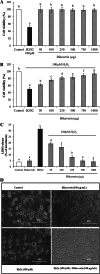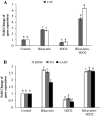Neuroprotective effects of bikaverin on H2O2-induced oxidative stress mediated neuronal damage in SH-SY5Y cell line
- PMID: 24848007
- PMCID: PMC11488908
- DOI: 10.1007/s10571-014-0073-6
Neuroprotective effects of bikaverin on H2O2-induced oxidative stress mediated neuronal damage in SH-SY5Y cell line
Abstract
The generation of free radicals and oxidative stress has been linked to several neurodegenerative diseases including Parkinson's disease, Alzheimer's disease, Huntington's disease, and Amyotrophic lateral sclerosis. The use of free radical scavenging molecules for the reduction of intracellular reactive oxygen species is one of the strategies used in the clinical management of neurodegeneration. Fungal secondary metabolism is a rich source of novel molecules with potential bioactivity. In the current study, bikaverin was extracted from Fusarium oxysporum f. sp. lycopersici and its structural characterization was carried out. Further, we explored the protective effects of bikaverin on oxidative stress and its anti-apoptotic mechanism to attenuate H2O2-induced neurotoxicity using human neuroblastoma SH-SY5Y cells. Our results elucidate that pretreatment of neurons with bikaverin attenuates the mitochondrial and plasma membrane damage induced by 100 µM H2O2 to 82 and 26% as evidenced by MTT and LDH assays. H2O2 induced depletion of antioxidant enzyme status was also replenished by bikaverin which was confirmed by Realtime Quantitative PCR analysis of SOD and CAT genes. Bikaverin pretreatment efficiently potentiated the H2O2-induced neuronal markers, such as BDNF, TH, and AADC expression, which orchestrate the neuronal damage of the cell. The H2O2-induced damage to cells, nuclear, and mitochondrial integrity was also restored by bikaverin. Bikaverin could be developed as a preventive agent against neurodegeneration and as an alternative to some of the toxic synthetic antioxidants.
Conflict of interest statement
Authors declare that there is no conflict of interest.
Figures





References
-
- Andersen JK (2004) Oxidative stress in neurodegeneration: cause or consequence? Nat Med 5:S18–S25 - PubMed
-
- Balan J, Fuska J, Kuhr I, Kuhrová V (1970) Bikaverin, an antibiotic from Gibberella fujikuroi, effective against Leishmania brasiliensis. Folia Microbiol 15:479–484 - PubMed
-
- Baraccaa A, Gianluca S, Giancarlo S, Giorgio L (2003) Rhodamine 123 as a probe of mitochondrial membrane potential: evaluation of proton flux through F0 during ATP synthesis. Biochim Biophys Acta 1606:137–146 - PubMed
-
- Bell AA, Wheeler MH, Liu J, Stipanovic RD, Puckhaber LS, Orta H (2003) United States Department of Agriculture-Agricultural Research Service. Studies on polyketide toxins of Fusarium oxysporum f. sp. vasinfectum: potential targets for disease control. Pest Manag Sci 59:736–747 - PubMed
-
- Brewer D, Arsenault GP, Wright C, Vining LC (1973) Production of bikaverin by Fusarium oxysporum and its identity with lycopersin. J Antibiot 26:778–781
Publication types
MeSH terms
Substances
LinkOut - more resources
Full Text Sources
Other Literature Sources
Miscellaneous

